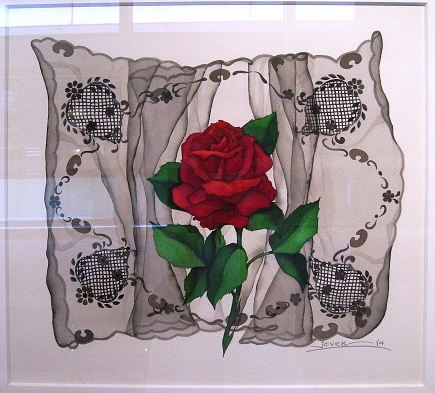Text and photos by ELIZABETH LOLARGA
ART has always been known as a great savior and healer for those in mourning. That was how Joven Ignacio, an architect, building science consultant and conservator of historical structures, found himself taking up the brush and watercolor pigments.
He recalled, “It was during my father’s hospitalization that I started painting to keep me preoccupied while staying at the hospital with him. He had a stroke and was bedridden for about five years until he passed away. We discover many things about ourselves during difficult times. Painting was my escape from reality.”
Ignacio’s solo exhibition, “Amoroso,” at Ayala Museum’s ArtistSpace is made up of more than 30 finely detailed watercolors that have for their subjects things from a seemingly vanished era of lacey shawls, embroidered fans and other heirloom pieces. The show explores the transparency of cloth, the soft, flowing movement of Philippine traditional weaves. Proceeds from the sale of his works will go to the Manila Chamber Orchestra Foundation’s (MCOF)Young Artists’ Development Program.
His works can be compared to the calado series of the more senior Araceli “Cheloy” Dans. He said, “I have a lot of respect and truly admire her. She has produced many works that inspire younger artists like me. I don’t think it is appropriate to be compared to a master like her. It is best that I work very hard to produce a body of work that is representative of one’s vision. Skills in art are a responsibility. We have to explore this for the right purpose.”
 He also admires National Artist Vicente Manansala, saying “He is a great inspiration to me. He was just fantastic. I admire his works so much. Audubon has his share of influence on me. There are many other artists I value. One is Napoleon Abueva whose creative genius and imagination is so impressive. I am grateful for his quiet guidance. He is my role model, you see.”
He also admires National Artist Vicente Manansala, saying “He is a great inspiration to me. He was just fantastic. I admire his works so much. Audubon has his share of influence on me. There are many other artists I value. One is Napoleon Abueva whose creative genius and imagination is so impressive. I am grateful for his quiet guidance. He is my role model, you see.”
Although other painters consider watercolor a difficult medium to master, Ignacio hasn’t explored any other medium. “Watercolor reveals new things to me. I am always challenged. There are many new discoveries as I use this. I try hard to do art by remembering images in my mind. I avoid painting with subjects in front of me. Probably because as an architect this is how we are trained to do our designs. We challenge our imagination always. As for the medium, it controls me, not the other way around. Perhaps this is why I can never tire of it. As to it being difficult, how can a friend be difficult once we have developed a good working relationship with each other? We learn more and more about each other as we grow older. Watercolor is a good friend and companion.”
With his full-time architectural practice, teaching duties at the UP College of Architecture and heritage advocacy, he has disciplined himself so he can find time for his avocation. He said, “I paint from 4 a.m. onwards before going to work at 9 a.m., then late at night after office. I’m lucky to sustain this.”
Asked for his reason behind his generous gesture towards the music foundation, he answered, “I do love music. What will we do without musicians? I paint with music as my background all the time. When the MCOF asked to do this project, there was no hesitation on my part. I’m grateful to our musicians. I will be very tired if I paint with no music in the background. I wish there are more hours in a day. There is just not enough time to do everything. Musicians have inspired me so much. I owe this project to them.”
Angeli Reyes-Nacino, MCOF executive director, explained the situation: “We have been faithful to our mission of promoting classical music, especially in nurturing young and promising musicians. We do not get government subsidy or corporate sponsorships. Sponsors have changed in perspective, values, priorities. They may support more popular advocacies or would rather support their own events. We have eaten into our own dwindling trust fund.”
Since 2008, the MCOF’s former bank partner had stopped supporting them. As a consequence, she said, “We reduced our number of concerts, stopped our outreach to poor communities and schools. We had no more home to give venue grants to deserving students who needed one for their graduation recitals and for music conservatories that used our former auditorium as venue for fundraising concerts to benefit their scholars. Our partnerships with the embassies for their cultural concerts and films were affected—they had to look for alternative venues.”
Ignacio’s gesture is thus timely, considering how the MCOF and similar institutions are struggling to keep afloat to keep fine music playing.
“Amoroso” runs until July 6.

